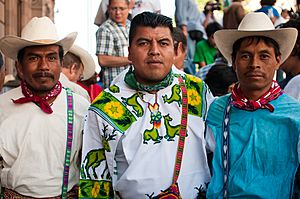Wirikuta facts for kids
Wirikuta is a special desert area in the mountains of central Mexico. It is very sacred to the Wixárika (also known as Huichol) people. For the Wixárika, Wirikuta is where the world was created.
Every year, the Wixárika people go on a long journey, called a pilgrimage, to Wirikuta. They travel about 250 miles (400 kilometers) from Jalisco to San Luis Potosí. This area is protected as a UNESCO Natural Sacred Area. However, it is currently at risk from a mining company called First Majestic Silver.
Contents
Why Wirikuta is Special
The Wixárika people believe the sun first appeared in Wirikuta. It is also the sacred land of their ancestors, whom they see as gods. They have important sacred places in each main direction and at the center:
- Teakata (Santa Catarina, Jalisco) – This is the Center.
- Huaxamanaka (Cerro Gordo, Durango) – This is the North.
- Haramara (San Blas, Nayarit) – This is the West.
- Xapawleyeta (Isla de los Alacranes del Lago Chapala, Jalisco) – This is the South.
- Wirikuta – This is the East.
Between October and March, the Huichol people follow the path of their gods from the sea (Haramara) to the place where the Sun first appeared (Reunax), which is Cerro Quemado (Leunaxü). Their gods were guided by Tatewari, the Grandfather Fire. They believe a deer (maxa) used its horns to lift the sun into the sky, bringing light to the world.
The Sacred Journey
To follow this sacred path, maraka'ames (shamans or spiritual leaders) and their communities travel 250 miles (400 kilometers) each year. They start in the Wixárika area of Jalisco and walk towards San Luis Potosí.
First, they visit Takata, a sacred area in the Sierra Madre Occidental. Here, the temple guard (xuxuricare) asks for a safe journey for them. Next, they go to kalihuey, a Main Temple, where they meet with Wixárika leaders.
Along the way, they collect a special cactus called peyote. The Wixárika people believe that peyote helps them connect directly with their ancestors and gods. At the end of their journey, they collect hikuri (peyote) and take it back home. This act helps them recreate the cycle of life.
Groups travel with a lead shaman, who guides them. Other shamans, apprentices, and families, including children, may also join. The lead shaman advises everyone on how to behave during the journey. Being pure and clean is very important. Participants may limit food, water, and sleep. Early in the journey, they take part in a special purification ritual. This helps them prepare for healing and growth. During this ritual, each person shares their past mistakes with the group. A fire is lit to honor Tatehuari, and a Maraka'me gently touches each speaker's legs with a stick. This helps them remember everything and not leave anything out.
The pilgrimage is a special journey that brings families and communities closer. It strengthens their cultural beliefs, practices, and values. It also helps people grow as individuals. On a personal level, the journey helps seekers find better health, understanding, and meaning in their lives. In short, it helps them "find their lives."
Threats to Wirikuta
Wirikuta, a very sacred place for the Huichol people, is now facing a big threat. A Canadian mining company, First Majestic Silver, wants to dig for silver there. They have permission from the Mexican government for their La Luz Silver Project. However, this project goes against laws that protect the Wirikuta area and the Wixárika people, both in Mexico and internationally.
The La Luz Silver Project is fully owned by First Majestic Silver Corp. They bought the land in 2009. The mining area covers 6,327 hectares (about 15,600 acres). It is located near Real de Catorce, a place that has been mined for silver for a long time. Between 1773 and 1990, about 230 million ounces of silver were found there. The project is in the northern part of San Luís Potosí State, Mexico. It is about 25 km west of Matehuala and 170 km north of San Luís Potosí city.
This mining project could harm the environment and the health of people living nearby. It is also causing problems among local communities, dividing them. Chemicals used in mining from older mines have already damaged resources. This has affected the environment and people's health. For example, new mines would use huge amounts of water in an area that is already very dry.
Animals and Plants of Wirikuta
Wirikuta is home to many different animals. There are 223 animal species living there. This includes 53 types of mammals, 141 kinds of birds, 32 types of reptiles, and 7 types of amphibians. The 141 bird species found in Wirikuta make up 15% of all the birds in Mexico!
Some of the animals you might find in Wirikuta are:
- Cynomys mexicanus (Mexican prairie dog)
- Vulpes macrotis (Northern desert fox)
- Taxidea taxus (giant badger)
- Falco mexicanus (Mexican hawk)
- Kinosternon integrum (mud turtle)
Wirikuta also has 567 different types of plants. Many of the cacti found in Wirikuta are on Mexico's list of endangered species. A large part of the plants and animals here are endemic. This means they can only be found in Wirikuta and nowhere else in the world.
Some of the plants in Wirikuta include:
- Lophophora williamsii (peyote)
- Ariocarpus retusus
- Manfreda brunnea
- Pinus culminicola
- Echinocactus
- Larrea tridentata
- Agave lechuguilla
- Yucca
- Mezquite
- Brahea berlandier
- Sedum catorce
- Astrophytum myriostigma
- There are 73 species of Cactaceae (cactus family).
- There are 300 species of Opuntia (prickly pear cactus).
- There are 393 species of Echeveria.
See also
 In Spanish: Wirikuta para niños
In Spanish: Wirikuta para niños


